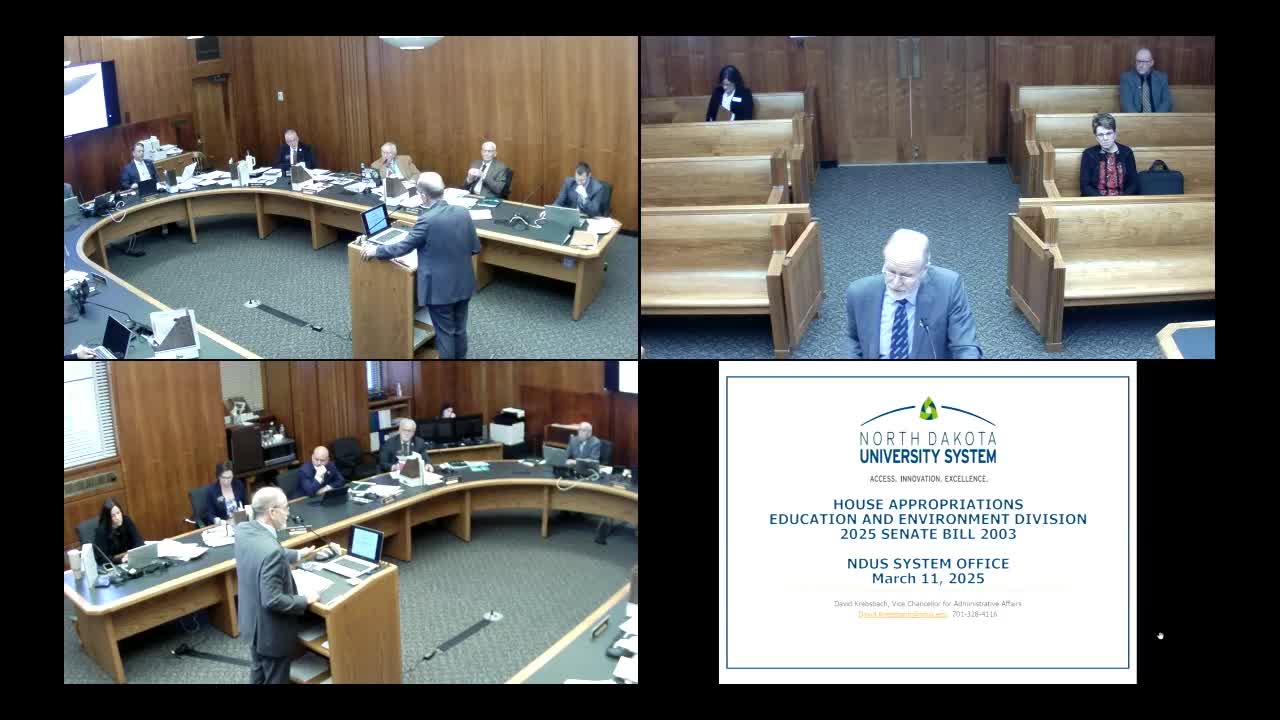North Dakota higher education leaders address workforce poaching and leadership transitions
March 11, 2025 | Appropriations - Education and Environment Division, House of Representatives, Legislative, North Dakota
This article was created by AI summarizing key points discussed. AI makes mistakes, so for full details and context, please refer to the video of the full meeting. Please report any errors so we can fix them. Report an error »

In a recent meeting of the North Dakota House Appropriations - Education and Environment Division, key discussions highlighted the challenges facing the state's higher education system, particularly regarding talent retention and program development. The meeting, held on March 11, 2025, addressed pressing issues such as the poaching of top professors and the need for innovative educational programs to meet evolving workforce demands.
Chancellor Dave Tremblak opened the discussion by acknowledging the increasing trend of talented faculty being recruited by other states, particularly in fields like engineering and computational sciences. This issue has been exacerbated by significant national initiatives, such as President Trump's $500 billion Stardate initiative, which aims to attract up to 100,000 tech workers and researchers. Tremblak emphasized the urgency of forming a five-state consortium with South Dakota, Montana, Wyoming, and Idaho to collaboratively address workforce shortages in artificial intelligence and related fields. This consortium aims to share resources and expertise to mitigate the effects of talent poaching.
The meeting also touched on the ongoing search for new leadership within the North Dakota higher education system. Tremblak, who plans to retire in December, expressed concerns about the board's decision to delay the search for his successor until after his departure. This decision has raised questions among legislators about the effectiveness of the transition process and the potential for rushed decision-making.
Another significant topic was the approval process for new academic programs. Tremblak explained that campuses are encouraged to adapt to local and national workforce needs, but concerns about duplication of programs across institutions remain. Legislators questioned the oversight mechanisms in place to prevent unnecessary program overlap, particularly in fields where demand is already being met by existing institutions.
The meeting concluded with a call for more streamlined processes to enhance collaboration among campuses and ensure that new programs are developed efficiently and effectively. As North Dakota's higher education landscape continues to evolve, the discussions from this meeting underscore the importance of strategic planning and cooperation to address the challenges of talent retention and program development in a competitive educational environment.
Chancellor Dave Tremblak opened the discussion by acknowledging the increasing trend of talented faculty being recruited by other states, particularly in fields like engineering and computational sciences. This issue has been exacerbated by significant national initiatives, such as President Trump's $500 billion Stardate initiative, which aims to attract up to 100,000 tech workers and researchers. Tremblak emphasized the urgency of forming a five-state consortium with South Dakota, Montana, Wyoming, and Idaho to collaboratively address workforce shortages in artificial intelligence and related fields. This consortium aims to share resources and expertise to mitigate the effects of talent poaching.
The meeting also touched on the ongoing search for new leadership within the North Dakota higher education system. Tremblak, who plans to retire in December, expressed concerns about the board's decision to delay the search for his successor until after his departure. This decision has raised questions among legislators about the effectiveness of the transition process and the potential for rushed decision-making.
Another significant topic was the approval process for new academic programs. Tremblak explained that campuses are encouraged to adapt to local and national workforce needs, but concerns about duplication of programs across institutions remain. Legislators questioned the oversight mechanisms in place to prevent unnecessary program overlap, particularly in fields where demand is already being met by existing institutions.
The meeting concluded with a call for more streamlined processes to enhance collaboration among campuses and ensure that new programs are developed efficiently and effectively. As North Dakota's higher education landscape continues to evolve, the discussions from this meeting underscore the importance of strategic planning and cooperation to address the challenges of talent retention and program development in a competitive educational environment.
View full meeting
This article is based on a recent meeting—watch the full video and explore the complete transcript for deeper insights into the discussion.
View full meeting
